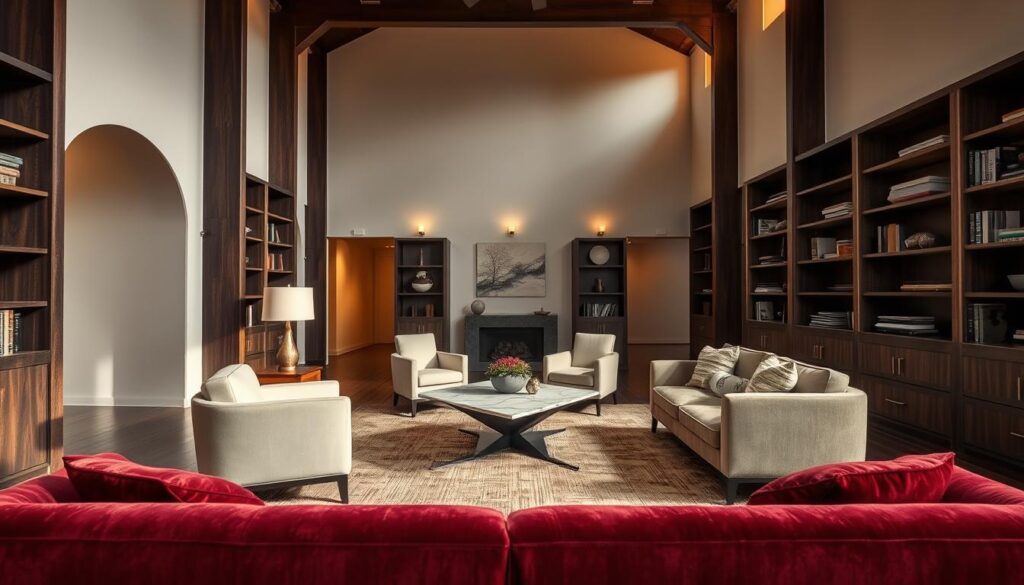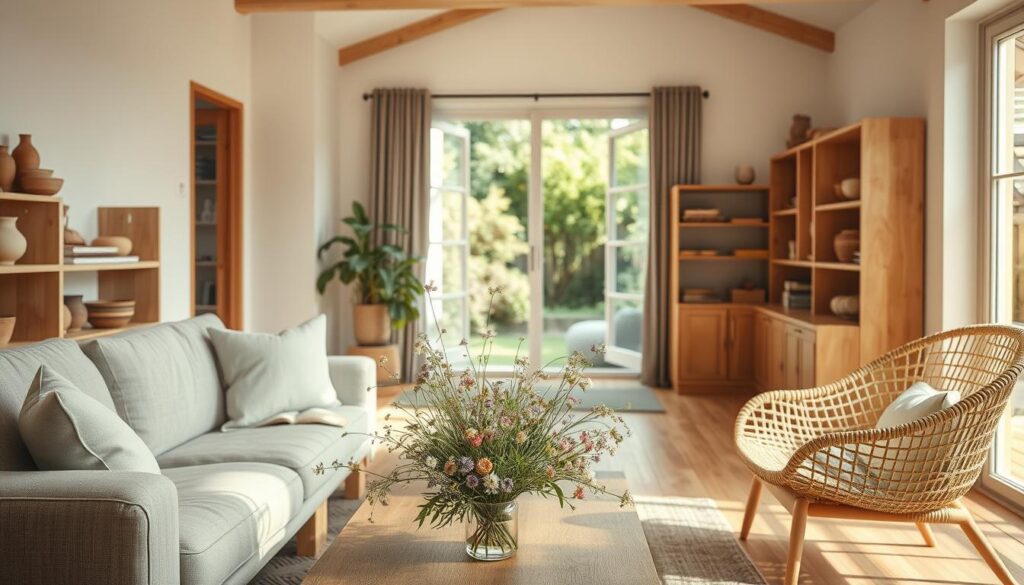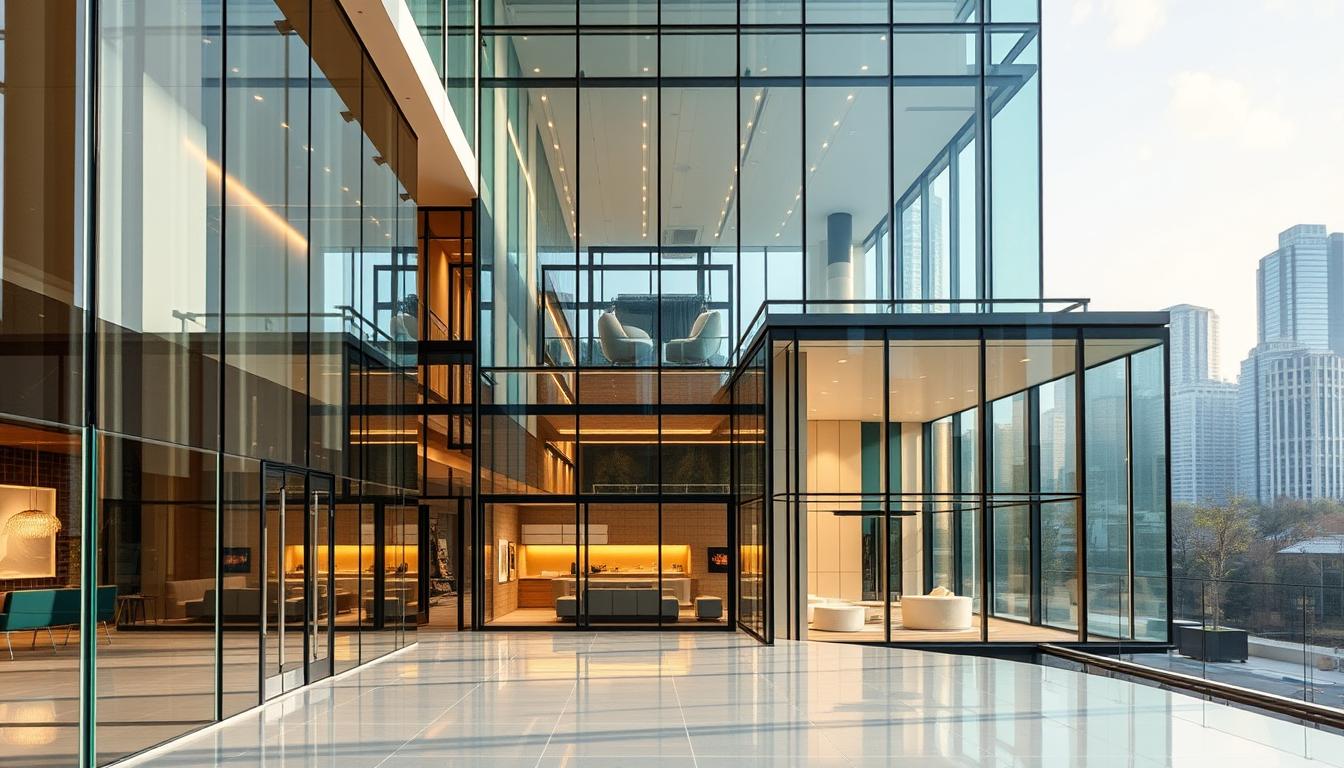Did you know a well-designed living space can make you happier and more productive? A modern home design is more than looks. It’s about making a space that works well and feels good.
We’ll share our best tips for a contemporary look that’s both classy and trendy. We’ll talk about picking the right colors, adding tech, and personal touches. These are key to making your living area special.
Key Takeaways
- Understand the principles of modern design
- Choose a sleek and stylish color palette
- Incorporate technology for a functional living space
- Add personal touches to make your space unique
- Balance elegance and comfort in your design
Understanding Contemporary Design
Contemporary interior design focuses on clean lines and minimal decor. It aims to blend indoors with outdoors seamlessly. This style is not just about looks; it’s about making spaces functional and cozy.
What Defines Contemporary Style?
Contemporary style is simple and clutter-free. It favors a minimalist decor where each item serves a purpose. Sleek home decor is key, with smooth surfaces and simple shapes.
Key Characteristics of Contemporary Interiors
Contemporary interiors are open, neutral, and functional. Here are some key traits:
- Open and airy spaces
- Neutral color schemes with pops of color
- Minimal ornamentation
- Emphasis on natural light
- Integration with outdoor spaces
| Characteristic | Description | Example |
|---|---|---|
| Open Floor Plans | Combining living, dining, and kitchen areas into a single, open space. | Removing walls between kitchen and living room. |
| Neutral Color Palettes | Using a base of neutral colors and adding accent colors. | White walls with a bold red sofa. |
| Minimal Ornamentation | Avoiding excessive decor and focusing on clean lines. | Simple window frames and minimal molding. |
Understanding these traits helps you create a stylish living space that follows contemporary design. It’s about finding a balance between modern and cozy.
Choosing a Color Palette
In modern interior design, the color palette is key to a harmonious and appealing space. A well-chosen color scheme can make your home look modern and welcoming.
Popular Color Schemes in Contemporary Homes
Modern homes often use simple yet striking color schemes. Neutral colors like whites, grays, and beiges are popular as a base. They offer a clean and elegant look for minimalist interior design.
These neutral bases are then highlighted with bold, vibrant colors. This adds depth and interest to the space.
For example, a white room can be made more interesting with a bold piece of art or a brightly colored rug. This creates a focal point that catches the eye and adds personality.
Tips for Mixing and Matching Colors
When mixing colors, understanding natural light is crucial. The light in your room affects how colors look. So, choose colors that work well with your room’s lighting.
Also, think about the colors of your furniture and decor. For an elegant home furnishings look, pick a few bold pieces and balance them with softer tones. The 60-30-10 rule is helpful: 60% of the room should be a main color, 30% a secondary color, and 10% an accent color.
- Start with a neutral base to provide a calm foundation.
- Add a secondary color that complements the neutral tone.
- Use an accent color to add a pop of color and create visual interest.
Selecting Furniture
Modern homes need the right furniture to look good and work well. The right pieces make a room look better and still be useful every day.
Essential Pieces for a Contemporary Space
In modern homes, some furniture is key for a stylish and unified look. These include:
- Sofas with simple designs and not too much padding, usually in neutral colors.
- Simple coffee tables made from glass or metal.
- Chairs that are both comfy and sleek.
These items add to the modern look and keep the space both stylish and practical.
Importance of Functionality and Form
In modern design, furniture must look good and work well. For example, a storage ottoman is stylish and useful.
Choosing furniture means picking items that are both attractive and useful. This mix makes sure the furniture looks great and makes the space better to live in.
By focusing on both looks and use, you can make a modern home that’s beautiful and functional. It shows off the latest in home decor and stylish room design.
Incorporating Artwork
Adding artwork to your home decor can really make it stand out. It brings in your personal style and taste. Artwork adds visual interest and shows who you are.
The Role of Art in Contemporary Design
Art is key in modern design, adding a unique touch. Contemporary art challenges old views of art and beauty. In a modern home, art can highlight a spot, add texture, and bring in color.
Art critics say, “Art is more than decoration; it shows who you are and where you belong.” Choosing the right artwork is tough, but pick pieces that speak to you and fit your decor.
Choosing the Right Art for Your Space
When picking art for your modern home, think about a few things:
- The style and colors of your interior
- The size of the art compared to your furniture
- The mood you want the art to create
A bold art piece can energize a room, while a calm landscape can soothe it. Mixing different styles and mediums makes your space more interesting.
Remember, adding art to your modern home is a way to express yourself. Have fun with it and try new things.
Lighting Solutions
In today’s interior design, lighting is more than just a need; it’s a statement. Good lighting can make a room feel bigger and more welcoming.
Types of Lighting for Contemporary Interiors
Modern homes use a mix of lighting types for a layered look. These include:
- Ambient Lighting: Gives a room overall light, making it safe to see and move.
- Task Lighting: Focuses on areas for tasks like reading or cooking.
- Accent Lighting: Shows off special features or art, adding interest.
How to Layer Lighting Effectively
Layering lighting means mixing light sources for a warm, inviting feel. Here’s how to do it:
- Begin with ambient lighting as the base.
- Add task lighting where needed.
- Use accent lighting to highlight special features.
This way, we can make a stylish living space that’s both good-looking and practical.
| Lighting Type | Purpose | Examples |
|---|---|---|
| Ambient | Overall illumination | Ceiling fixtures, LED panels |
| Task | Focused lighting for tasks | Desk lamps, under-cabinet lighting |
| Accent | Highlighting features | Track lighting, picture lights |
In summary, lighting is key in modern interior design. Knowing the different types and how to layer them helps us create stylish living spaces that are both beautiful and useful.
Textures and Materials
Using different textures and materials can make a space look more sophisticated. In modern interior design, picking the right textures and materials is key. It helps create a space that looks good and feels welcoming.

Popular Materials in Contemporary Interiors
Modern interiors often use wood, metal, and glass. These materials add depth and interest. For example, wood makes a space feel cozy. Metal gives it a modern look. Glass makes rooms feel bigger and more open.
- Wood: Adds warmth and coziness
- Metal: Provides a sleek, modern touch
- Glass: Creates a sense of openness
Mixing Textures for Visual Interest
Mixing textures makes a space rich and inviting. Combining smooth and rough textures adds complexity. For instance, a smooth leather sofa looks great with a rough woven rug.
To keep things balanced, follow minimalist interior design principles. Choose a few standout pieces and pair them with simpler ones. This keeps the space clean and elegant.
“The art of interior design is not just about filling space, but about creating an atmosphere that resonates with the inhabitants.”
Begin with a main texture and add others to enhance it. For example, a wooden floor looks good with a metallic coffee table and a glass vase. This mix creates a balanced look that’s elegant.
Open Floor Plans
The trend of open floor plans is growing fast. It changes how we live and interact in our homes. By removing walls, these plans make spaces feel bigger and more open, showing off modern design.
Advantages of Spacious Layouts
Open floor plans bring many benefits. They let in more natural light and help people connect better. Without walls, light moves freely, brightening the space. Plus, they make it easier for family and friends to hang out together, perfect for today’s living.
“An open floor plan is not just about removing walls; it’s about creating a lifestyle that is more connected and interactive.”
Some key advantages of open floor plans include:
- Increased sense of space and freedom
- Enhanced natural lighting
- Improved social interaction
- Flexibility in furniture arrangement
Creating a Seamless Flow
To make your home flow well, use area rugs, smart furniture, and soft dividers. Area rugs can mark off different spots in the open space. Furniture placement helps guide movement.
| Element | Purpose | Tips |
|---|---|---|
| Area Rugs | Define spaces | Choose rugs that complement the overall color scheme |
| Furniture Arrangement | Guide movement | Arrange furniture to create a natural flow |
| Subtle Dividers | Separate areas | Use dividers that are aesthetically pleasing and functional |
By adding these touches, you can make your home stylish and useful. Open floor plans, done right, make your home look great and feel welcoming. They mix trendy decor with practical living space perfectly.
Accessorizing Thoughtfully
In today’s home design, picking the right accessories is crucial. They can transform a room, adding personality and depth. It’s all about choosing wisely.
Key Accessories for a Contemporary Look
When accessorizing, pick items that fit your modern home. Look for geometric vases, abstract sculptures, and minimalist wall decor. These add interest without making the space feel crowded.
Adding unique, personal touches is also important. You can find inspiration for your home at https://homemoodid.com/elevate-your-home-with-these-modern-interior-designs/. It offers a range of modern styles and accessories.
The Art of Minimalist Decoration
Minimalist decoration is about choosing carefully. It’s better to have a few meaningful pieces than many that don’t stand out. This keeps your home looking clean and stylish.
To get a minimalist look, focus on the quality of your accessories. Each piece should have a purpose or bring happiness. This way, your home will look cohesive and chic.
Sustainable Practices
In today’s interior design, going green is key. We’re all about making our homes eco-friendly. This means using materials that are good for the planet.
Using eco-friendly materials is a big part of being green. Think recycled, recyclable, or sustainably sourced stuff. For example, reclaimed wood, bamboo, and paints with low VOCs are big hits.
Eco-Friendly Materials and Designs
There are many eco-friendly materials out there. Here are a few:
- Reclaimed or sustainably sourced wood for furniture and flooring
- Bamboo products, known for their fast growth rate and sustainability
- Low-VOC paints and finishes to improve indoor air quality
- Recycled glass countertops and decorative elements
- Sustainable textiles, such as organic cotton or hemp, for upholstery
These materials make your home greener and add style.

The Importance of Sustainability
Sustainability is important for many reasons. It cuts down on waste and saves resources. It also makes homes healthier by improving air quality.
Let’s compare traditional vs. eco-friendly materials:
| Material | Environmental Impact | Health Benefits |
|---|---|---|
| Traditional Wood Flooring | High: Deforestation, processing energy | Low: Potential for VOC emissions |
| Reclaimed Wood Flooring | Low: Reduces waste, less processing needed | High: Unique character, less VOCs |
| Synthetic Carpets | High: Made from non-renewable resources, off-gassing | Low: Can emit VOCs, harbor allergens |
| Natural Fiber Carpets | Low: Biodegradable, less harmful production | High: Better indoor air quality, durable |
Choosing green materials makes our homes stylish, comfy, and good for the planet.
Technology in Home Design
In today’s homes, technology is key for both looks and function. We aim for a mix of beauty and usefulness. Smart home features let us control our homes easily.
Smart Home Features for Modern Living
Smart home tech includes many devices to make life easier. Some main features are:
- Automated lighting that changes with the day and who’s home
- Thermostats that learn your heat preferences
- Home security systems you can check on your phone
- Voice assistants that work with smart devices
These features make our homes better, save energy, and keep us safe. For example, smart lights can cut down on energy use by turning off when not needed.
Integrating Technology Seamlessly
Technology is great, but it must fit with our home’s look. A minimalist interior design helps by focusing on simplicity, even with tech.
Here are tips to blend tech with your home’s style:
- Pick devices that look good with your home
- Choose wireless tech to avoid clutter
- Use smart hubs to control everything from one place
Designer Jonathan Adler says, “Technology should improve our homes, not take over.” This idea is key for a elegant home furnishings look that’s both stylish and useful.
“The best technology is invisible, and that’s what we’re striving for in smart home design.”
Let’s look at how smart home features compare to old-school ones, like lighting:
| Feature | Traditional Lighting | Smart Lighting |
|---|---|---|
| Control | Manual switching | Remote control/app control |
| Energy Efficiency | Limited to bulb type | Automated scheduling and adjustments |
| Customization | Limited dimming capabilities | Wide range of dimming and color options |
By using smart home tech wisely, we can make our homes beautiful, useful, and efficient.
Personal Touches
To make your home truly yours, add personal touches that tell your story. These elements add character and warmth to your space.
Infusing Your Personality
Using personal artifacts, unique art, and customized furniture is a great way to add a personal touch. Displaying family heirlooms or collectibles can deepen your contemporary interior. You can also explore French home interior ideas for elegance and sophistication.
Artwork is another excellent way to personalize your space. Choose pieces that resonate with you, like paintings, sculptures, or photographs. It’s not just about matching colors; it’s about pieces that hold personal significance or emotional value.
Balancing Personalization and Contemporary Style
The challenge is balancing personal elements with contemporary design’s clean lines and minimalism. Here are some tips:
- Begin with a neutral base that follows contemporary design principles.
- Add personal touches gradually, ensuring they complement the overall aesthetic.
- Use a unifying theme or color scheme to tie personal elements together with your decor.
Here’s a simple table to show how to balance personal touches with contemporary style:
| Personal Touch | Contemporary Element | Result |
|---|---|---|
| Vintage Rug | Minimalist Furniture | Warm, Inviting Space |
| Family Photos | Simple Frames | Personalized yet Sleek |
| Custom Artwork | Neutral Color Palette | Unique, Contemporary Feel |
By carefully adding personal touches and balancing them with contemporary design, you can create a stylish and deeply personal home.
Maintaining a Cohesive Look
A well-designed contemporary home interior needs careful thought. We must pick a look we love and stick to it. This makes our home look sleek and stylish.
Consistency in Design Elements
For a cohesive look, choose one color palette and furniture style. This creates a smooth flow and harmony in our modern home.
Avoiding Design Pitfalls
Design mistakes like clutter and mismatched textures can ruin our home’s look. We can avoid these by picking a few standout pieces. Then, add neutral items to balance them out.
By following these tips, we can make our home both beautiful and functional. It will show off our personal style perfectly.


